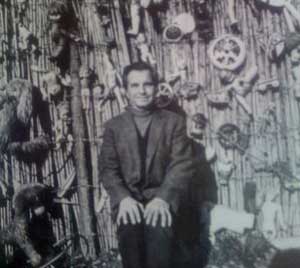
Pavel Zoubok Gallery is pleased to present an exhibition of mixed-media works and drawings by SALVATORE MEO (1914-2004). Please join us for the opening reception on Thursday, November 13, from 6-8pm or during the run of the exhibition, which continues through December 20.
The gallery is located at: 533 West 23rd Street (between 10th & 11th Avenues)
Gallery Hours: Tuesday – Saturday, 10am-6pm
Once considered a pioneer of assemblage, SALVATORE MEO diligently incorporated the found object in his work during a near fifty-year career. He was one of the first American artists to use objects from nature and discarded man-made materials prior to a renewed interest in Dada during the 1950s with the publication of Robert Motherwell’s The Dada Painters and Poets (1951) and the installation of the Arensberg Collection at the Philadelphia Museum of Art. Born in South Philadelphia of Italian parents in 1914, Meo studied at The University of the Arts, Tyler School of Art and the Barnes Foundation. He worked in Stanley Hayter’s atelier and was involved with the Philadelphia Print Club. A Tiffany Foundation grant in 1949 allowed the 35-year-old artist to study in Italy and by 1951, he was a permanent resident in Rome and began exhibiting there with a solo exhibition at the Vetrina di Chiurazzi Gallery. During the period of the Gruppo Origine, the important post-Futurist review Arti Visive introduced a new generation of artists such as Alberto Burri, Piero Dorazio, Enrico Prampolini, and Achille Perilli. Meo served as the US arts editor for Arti Visive through which he actively promoted his Italian colleagues in Philadelphia and New York, where he kept a second studio. Despite taking an active role within the Italian arts community and receiving early acclaim both in the US and abroad, Meo remained outside the mainstream.
An iconoclast and trailblazer, Meo created mixed media constructions with a particular interest in drawing and gestural abstraction. To say that his collages and assemblages drew upon the most humble of materials would be an understatement. His primary sources were broken and/or discarded objects from the street - dresser drawers, old toys, scraps of clothes, torn packages, shoes heels, bones, string, and rusted wire. Meo was not concerned with the alchemical transformation of the commonplace, the search for hidden “jewels”, or the Surrealist double-entendre of the objet trouve. Rather, his was a poetic exploration of abandonment, decay and destruction. In contrast to his Pop and Nouveau Realist contemporaries such as Robert Rauschenberg and Mimmo Rotella, Meo rejected the seductive imagery of the commercial world. His works reverberate with a melancholy and sense of alienation reflecting not only his estrangement from the cultural mainstream, but his deep empathy for the dispossessed, be they objects or people. In this sense, his work shares a greater affinity with contemporary figures such as Jannis Kounellis and David Hammons.
Meo garnered serious attention from leading Italian avant-garde critics and artists. He exhibited widely during the 1950s with Burri, Capogrossi, Dorazio, Matta, Prampolini, Rotella and others. While Meo’s pioneering use of found materials eluded general audiences, his influence on the artists of the period and those that followed was almost universally acknowledged by progressive critics. Meo’s political rejection by the jury of the 1956 Venice Biennale was reversed by his inclusion in the next Biennale. Three years later, William C. Seitz included Meo in his seminal exhibition “The Art of Assemblage” at the Museum of Modern Art in New York. This was the first major museum survey of the medium and included important works by Picasso, Schwitters, Rauschenberg, Bontecou, Rotella and many modern and contemporary masters. Simultaneously, the Charles Egan Gallery presented a solo exhibition of Meo’s assemblages from 1946-1961, with favorable reviews published in The New York Times and Art News. Later, noted Italian critics Emilio Villa and Mario Diacono presented Salvatore Meo at the Metropolitan Gallery in Rome.
An “artist’s artist” and equally important a “critic’s artist,” Meo’s impact was deeply felt. The catalogue from his 1971 exhibition at the CIAK gallery in Rome documented his influence with writings by key Italian art world writers including Achille Bonito Oliva, Mario Diacono, Milton Gendel, Emilio Villa and Cesare Vivaldi. The occasion drew particular attention to Meo’s largely unacknowledged role as a forebear of Arte Povera, substantiated by his much earlier work with humble, or poor, materials.
Following his death in 2004, the Fondazione Salvatore Meo was created to preserve and promote Meo’s rich artistic legacy. His studio, located directly behind the Trevi fountain in Rome, has been preserved in its original state and is home to hundreds of works spanning some five decades. Reconstruction: The Art of Salvatore Meo accompanies a second exhibition, Salvatore Meo: Assemblages (1948-1978), at the Rosenwald-Wolf Gallery (The University of the Arts, Philadelphia), curated by Sid Sachs. These two surveys of Meo’s work are accompanied by a full-color catalogue, published with the generous support of the Judith Rothschild Foundation and the Italian Cultural Institute of New York.
Commenti |
||
| nessun commento... | ||